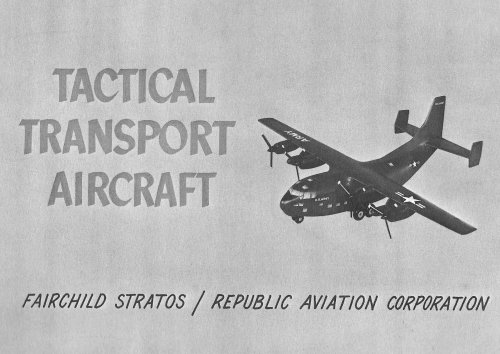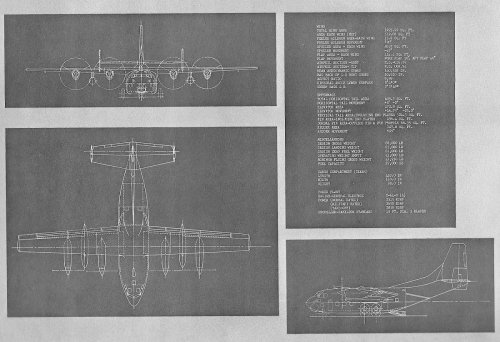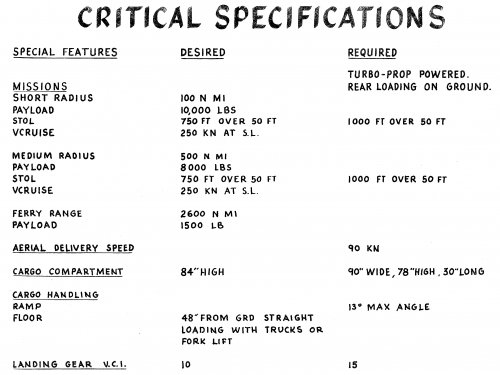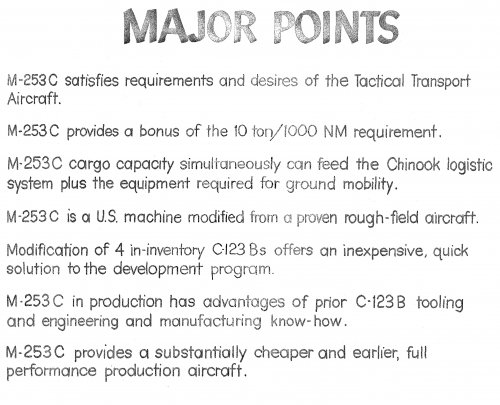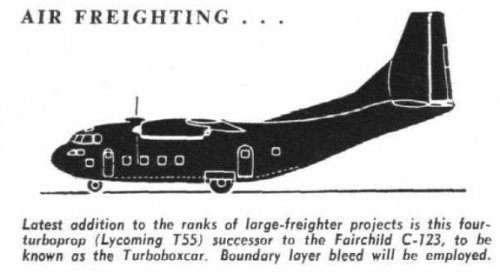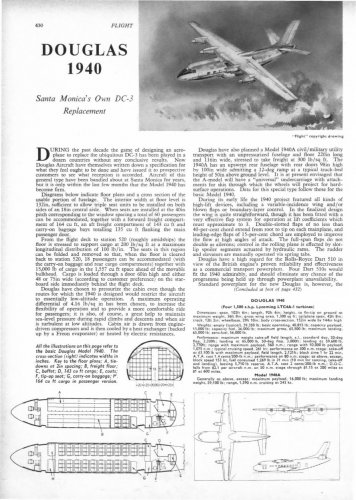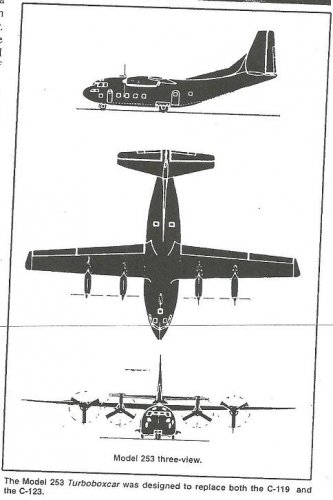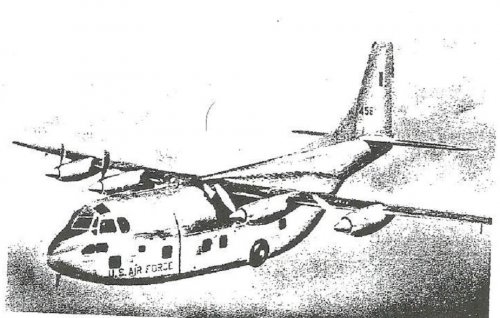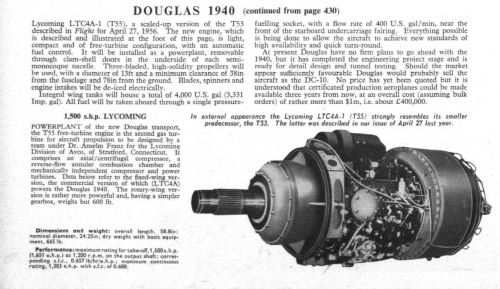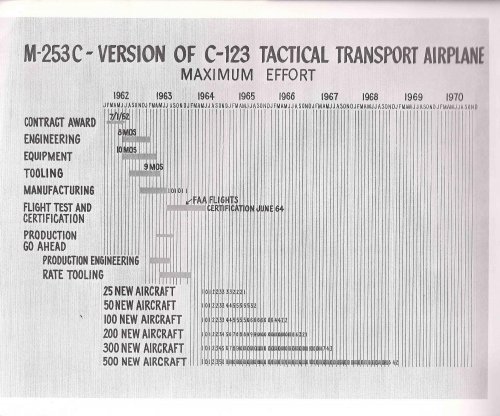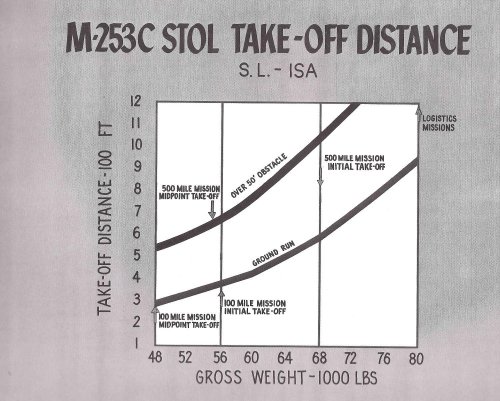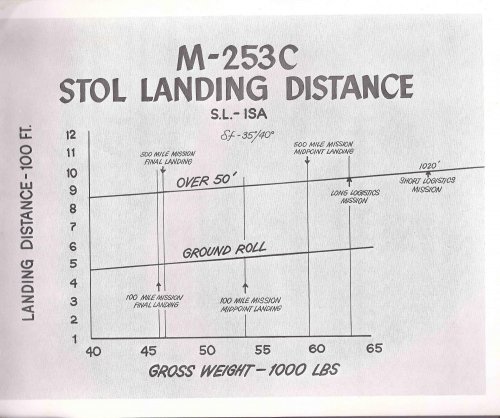You are using an out of date browser. It may not display this or other websites correctly.
You should upgrade or use an alternative browser.
You should upgrade or use an alternative browser.
Fairchild M-253C Transport
- Thread starter boxkite
- Start date
- Joined
- 22 January 2006
- Messages
- 3,963
- Reaction score
- 1,349
Fairchild C-82 Packet/C-119 Flying Boxcar (Aerofax) by Alwyn T Lloyd pg 43 and 44
By the early-to-mid 1960s, the USAF was interested in pursuing a turboprop conversion for the C-119. Such an aircraft was needed in limited war areas such as SE Asia. Aeronautical Systems Division at Wright Paterson AFB carried out a feasibility study to determine if Allison T56-A-7 engines could be retrofitted on C-119C/G/J aircraft. Delivery of a flying prototype was anticipated in 120 days. 3 companies teamed together for the feasibility study: Skyways Inc, On Mark Engineering Co and SECDO.
At the end, the proposal never went beyond the design phase.
No drawing available
By the early-to-mid 1960s, the USAF was interested in pursuing a turboprop conversion for the C-119. Such an aircraft was needed in limited war areas such as SE Asia. Aeronautical Systems Division at Wright Paterson AFB carried out a feasibility study to determine if Allison T56-A-7 engines could be retrofitted on C-119C/G/J aircraft. Delivery of a flying prototype was anticipated in 120 days. 3 companies teamed together for the feasibility study: Skyways Inc, On Mark Engineering Co and SECDO.
At the end, the proposal never went beyond the design phase.
No drawing available
- Joined
- 3 January 2006
- Messages
- 1,057
- Reaction score
- 576
pometablava said:Fairchild C-82 Packet/C-119 Flying Boxcar (Aerofax) by Alwyn T Lloyd pg 43 and 44
By the early-to-mid 1960s, the USAF was interested in pursuing a turboprop conversion for the C-119. Such an aircraft was needed in limited war areas such as SE Asia. Aeronautical Systems Division at Wright Paterson AFB carried out a feasibility study to determine if Allison T56-A-7 engines could be retrofitted on C-119C/G/J aircraft. Delivery of a flying prototype was anticipated in 120 days. 3 companies teamed together for the feasibility study: Skyways Inc, On Mark Engineering Co and SECDO.
At the end, the proposal never went beyond the design phase.
No drawing available
In all fairness, the C-119 fleet had seen a great deal of use from Korea onward.
These aircraft also had a structural peculiarity....the tail booms would snap off after a hard landing. I don't know if the same issue effected the earlier C-82 or the Nordatlas?
- Joined
- 25 June 2009
- Messages
- 13,941
- Reaction score
- 3,574
AeroFranz said:Very interesting stuff!
I wonder if anyone back then had the slightest idea of the importance of the competition, keeping in mind the volume of Herc sales in the coming decades.
Most probably not. Even keeping the DC-3's huge success in mind, it was only 2 decades old when it was replaced! I'm sure no-one could possibly imagine for an aircraft type to last over SIX decades!
Jos Heyman
ACCESS: Top Secret
- Joined
- 15 February 2007
- Messages
- 597
- Reaction score
- 62
I have some problem with the suggestion that the Fairchild M-253C was part of the competition that led to the C-130.
The request for proposals for the C-130 was issued on 2 February 1951, whereas, based on the sequence in the Fairchild model list the M-253C might have been from 1956/57 (M-232 was in 1956 and M-255 in 1957), a date also suggested by Hesham.
By that time various versions of the C-130 were already ordered and were flying (the first C-130A flew on 7 April 1955).
Also looking at the images of the M-253C - clearly a four engined version of the C-123, I doubt that it would have had the same capacity as the C-130 - but I might be mistaken. Finally, from the picture of the M-253C it looks that it was aimed at the US Army and not the USAF.
There was a Fairchild YC-136, a development of the C-123B but not too much info on that seems to be available to suggest that the M-253C might be linked to that designation. Moreover, the designation was requested in June 1954 - perhaps a little bit too early for the M-253C design.
And just in case somebody is wondering about the Fairchild C-138 designation - it seems that was a possible 1958/59 designation for a military version of the Fairchild (Fokker) Friendship (M-258F).
Nevertheless looking at the M-253C, it is an interesting proposal. Thanks for posting that.
The request for proposals for the C-130 was issued on 2 February 1951, whereas, based on the sequence in the Fairchild model list the M-253C might have been from 1956/57 (M-232 was in 1956 and M-255 in 1957), a date also suggested by Hesham.
By that time various versions of the C-130 were already ordered and were flying (the first C-130A flew on 7 April 1955).
Also looking at the images of the M-253C - clearly a four engined version of the C-123, I doubt that it would have had the same capacity as the C-130 - but I might be mistaken. Finally, from the picture of the M-253C it looks that it was aimed at the US Army and not the USAF.
There was a Fairchild YC-136, a development of the C-123B but not too much info on that seems to be available to suggest that the M-253C might be linked to that designation. Moreover, the designation was requested in June 1954 - perhaps a little bit too early for the M-253C design.
And just in case somebody is wondering about the Fairchild C-138 designation - it seems that was a possible 1958/59 designation for a military version of the Fairchild (Fokker) Friendship (M-258F).
Nevertheless looking at the M-253C, it is an interesting proposal. Thanks for posting that.
- Joined
- 25 June 2009
- Messages
- 13,941
- Reaction score
- 3,574
Jos Heyman said:I have some problem with the suggestion that the Fairchild M-253C was part of the competition that led to the C-130.
The request for proposals for the C-130 was issued on 2 February 1951, whereas, based on the sequence in the Fairchild model list the M-253C might have been from 1956/57 (M-232 was in 1956 and M-255 in 1957), a date also suggested by Hesham.
By that time various versions of the C-130 were already ordered and were flying (the first C-130A flew on 7 April 1955).
Also looking at the images of the M-253C - clearly a four engined version of the C-123, I doubt that it would have had the same capacity as the C-130 - but I might be mistaken. Finally, from the picture of the M-253C it looks that it was aimed at the US Army and not the USAF.
There was a Fairchild YC-136, a development of the C-123B but not too much info on that seems to be available to suggest that the M-253C might be linked to that designation. Moreover, the designation was requested in June 1954 - perhaps a little bit too early for the M-253C design.
And just in case somebody is wondering about the Fairchild C-138 designation - it seems that was a possible 1958/59 designation for a military version of the Fairchild (Fokker) Friendship (M-258F).
Nevertheless looking at the M-253C, it is an interesting proposal. Thanks for posting that.
Couldn't agree more. I too thought something was weird about date and capacity... glad you said so!
I have the C-136 in my list as being "reassigned to a proposed improved version of C-123B Provider, cancelled early in the design stage" so it could definitely be this...
The fact that the C-138 was "possibly planned for a civilian Fairchild F-27 variant, but not taken up" is interesting too because the F-27 was the M-258, so in terms of chronology it works pretty well.
Oh, by the way, I already had the M-253 (without the suffix) in my list, described as the "TURBOBOXCAR, a project based on C-123 with 4 x Lycoming T55 turboprop engines".
So now that beast has a name I guess...
Jos Heyman
ACCESS: Top Secret
- Joined
- 15 February 2007
- Messages
- 597
- Reaction score
- 62
Hesham, we have just put up a sound argument that the M-253 is from a different era than the basic C-130. If, however, you have a specific reference where your suggestion is stated, please let us know.
It may be that the M-253 was designed in competition with a sub-version of the C-130, in which case I would expect such a reference source to mention that sub-version rather than the generic C-130. May be the C-130E, but I would think that, from a commercial perspective, it would be a rather ill thought idea for Fairchild to propose a competitor to the C-130E.
It may be that the M-253 was designed in competition with a sub-version of the C-130, in which case I would expect such a reference source to mention that sub-version rather than the generic C-130. May be the C-130E, but I would think that, from a commercial perspective, it would be a rather ill thought idea for Fairchild to propose a competitor to the C-130E.
- Joined
- 27 December 2005
- Messages
- 16,722
- Reaction score
- 20,509
Added in an earlier reference to "TURBOBOXCAR" from Janes All The World's Aircraft 1957-1958 which confirms the timeline.
Flight references too:
http://www.flightglobal.com/pdfarchive/view/1957/1957%20-%201635.html
Fairchild Turboboxcar
The basic advantages of the design of the C-123 Provider—a Chase design which Fairchild have built in quantity for the U.S.A.F.—are such that the company have developed from it a very attractive STOL multi-purpose freight and passenger machine powered by four 1,600 h.p. turboprops.
Weighing 75,000 lb, the Turboboxcar would employ flap-blowing to reduce take-off and landing distances to some 1,700ft. A payload of 21,439 lb could be hauled an ultimate distance of 1,500 miles at 216 kt (248 m.p.h.). Engines will probably be Lycoming T55s or Rolls-Royce Darts.
Flight references too:
http://www.flightglobal.com/pdfarchive/view/1957/1957%20-%201635.html
Fairchild Turboboxcar
The basic advantages of the design of the C-123 Provider—a Chase design which Fairchild have built in quantity for the U.S.A.F.—are such that the company have developed from it a very attractive STOL multi-purpose freight and passenger machine powered by four 1,600 h.p. turboprops.
Weighing 75,000 lb, the Turboboxcar would employ flap-blowing to reduce take-off and landing distances to some 1,700ft. A payload of 21,439 lb could be hauled an ultimate distance of 1,500 miles at 216 kt (248 m.p.h.). Engines will probably be Lycoming T55s or Rolls-Royce Darts.
- Joined
- 9 October 2009
- Messages
- 20,457
- Reaction score
- 11,194
Jos Heyman said:Hesham, we have just put up a sound argument that the M-253 is from a different era than the basic C-130. If, however, you have a specific reference where your suggestion is stated, please let us know.
It may be that the M-253 was designed in competition with a sub-version of the C-130, in which case I would expect such a reference source to mention that sub-version rather than the generic C-130. May be the C-130E, but I would think that, from a commercial perspective, it would be a rather ill thought idea for Fairchild to propose a competitor to the C-130E.
I think hesham was trying to say that the M-253C was developed from an earlier M-253 that went up against the C-130. Paul seems to have put to rest that possibility though.
- Joined
- 27 December 2005
- Messages
- 16,722
- Reaction score
- 20,509
Attachments
- Joined
- 27 December 2005
- Messages
- 16,722
- Reaction score
- 20,509
http://www.flightglobal.com/FlightPDFArchive/1957/1957%20-%200564.PDF
USING the appellation Turboboxcar, Fairchild are developing a completely new short-field military and civil transport powered by four 1,600 h.p. Lycoming T55 turbines (the engine specified for the rather similar Douglas 1906 and 1940).
Employing boundary-layer control, the high-wing Turboboxcar will weigh 75,000 lb, cruise at 216 kt and lift 32,181 lb for short hauls and 21,439 lb over 1,500 miles ultimate. Minimum landing and take-off distances are, respectively, 1,610 and 1,750ft. A prototype may be financed with company money and could fly in twelve months' time.
USING the appellation Turboboxcar, Fairchild are developing a completely new short-field military and civil transport powered by four 1,600 h.p. Lycoming T55 turbines (the engine specified for the rather similar Douglas 1906 and 1940).
Employing boundary-layer control, the high-wing Turboboxcar will weigh 75,000 lb, cruise at 216 kt and lift 32,181 lb for short hauls and 21,439 lb over 1,500 miles ultimate. Minimum landing and take-off distances are, respectively, 1,610 and 1,750ft. A prototype may be financed with company money and could fly in twelve months' time.
- Joined
- 25 June 2009
- Messages
- 13,941
- Reaction score
- 3,574
Grey Havoc said:I think hesham was trying to say that the M-253C was developed from an earlier M-253 that went up against the C-130. Paul seems to have put to rest that possibility though.
Let's put it this way:
- Fairchild's M-list ran over three decades and was strictly chronological.
- Lockheed's L- list was also strictly chronological at the time.
- The USAF's C- list was, of course, completely chronological too.
- Fairchild's C-123 existed before the C-130. It was the M-205 but was itself derived from the post-war CG-20 and C-123 (Chase MS-8 Avitruc), therefore a much older design.
- The M-253 appeared in 1957, a good five years after Lockheed's L-206, which became the Hercules.
- Joined
- 27 December 2005
- Messages
- 16,722
- Reaction score
- 20,509
I remember Fairchaild Aircraft where I worked from 1957 - 1963. Fairchild was the Air Force transport builder of choice. The Air Force came out with a requirement for a four engine transport that used the Allison turboprop package as used on the Electra. The engineers had a design ready. No, said ccorporate management, you really need the C119 retrofitted with that package to be known as the Turboboxcar. Nope, the AF really wanted the C130. End of story, end of Fairchild as producer of AF transports. The C123 never amounted to much and the C130 still goes on 45 years later. Thanks for listening guys.
http://www.rcgroups.com/forums/showthread.php?t=50522&page=3
Interesting recollection, he seems to suggest "Turboboxcar" was first associated with a turboprop C-119.
- Joined
- 27 December 2005
- Messages
- 16,722
- Reaction score
- 20,509
Also from 1957, also using 4 x T55 turboprops, the Douglas Model 1940 "DC-3 replacement"
http://www.flightglobal.com/pdfarchive/view/1957/1957%20-%200428.html
http://www.flightglobal.com/pdfarchive/view/1957/1957%20-%200428.html
Attachments
- Joined
- 25 June 2009
- Messages
- 13,941
- Reaction score
- 3,574
PaulMM (Overscan) said:I remember Fairchaild Aircraft where I worked from 1957 - 1963. Fairchild was the Air Force transport builder of choice. The Air Force came out with a requirement for a four engine transport that used the Allison turboprop package as used on the Electra. The engineers had a design ready. No, said ccorporate management, you really need the C119 retrofitted with that package to be known as the Turboboxcar. Nope, the AF really wanted the C130. End of story, end of Fairchild as producer of AF transports. The C123 never amounted to much and the C130 still goes on 45 years later. Thanks for listening guys.
http://www.rcgroups.com/forums/showthread.php?t=50522&page=3
Interesting recollection, he seems to suggest "Turboboxcar" was first associated with a turboprop C-119.
Interesting indeed, but the end of the text suggests that his writing "C-119" was more likely a typo. What it says about the chronology is this!
- the Fairchild engineers had a design (so, something totally new, not a C-123);
- Fairchild's management said no, and pushed the Turboboxcar retrofit instead;
- Presented with the Turboboxcar and the C-130, the Air Force prefered the C-130.
- The author concludes that the AF made the right choice since the C-130 is still going strong while the C-123 (not the C-119) never amounted to much.
- Joined
- 27 December 2005
- Messages
- 16,722
- Reaction score
- 20,509
In response to a U.S. Army requirement for a tactical airlifter to supply the battlefront with troops and supplies and evacuate casualties on the return journey, de Havilland Canada designed the DHC-4. With assistance from Canada's Department of Defence Production, DHC built a prototype demonstrator that flew for the first time on 30 July 1958.
I think this may be the key to understanding this 1957 STOL C-123 derivative. Caribou is smaller; the C-123 derivative is overkill for the requirement but quick to build as a mod of existing aircraft.
- Joined
- 25 June 2009
- Messages
- 13,941
- Reaction score
- 3,574
PaulMM (Overscan) said:I think this may be the key to understanding this 1957 STOL C-123 derivative. Caribou is smaller; the C-123 derivative is overkill for the requirement but quick to build as a mod of existing aircraft.
Now THAT makes a lot more sense! Thanks for this find.
- Joined
- 27 December 2005
- Messages
- 16,722
- Reaction score
- 20,509
https://www.google.co.nz/url?sa=t&rct=j&q=&esrc=s&source=web&cd=1&cad=rja&ved=0CCsQFjAA&url=http%3A%2F%2Fwww.ai-online.com%2FAdv%2Fcatalog%2FdownloadCatalog.php%3Fid%3D529&ei=hxntUf2hAcayiQeX_YDoAg&usg=AFQjCNFgt0rAtRAM8DDDCW3oPcvKxfo6kQ&bvm=bv.49478099,d.aGc
Fairchild Engine & Airplane Corp. is proceeding with production of a prototype of a new four-engine aircraft to be known as the Turboboxcar.It is being financed in its present stage by Fairchild, and will be equipped with Lycoming T-55 turboprop engines of about 1600 hp each.
The plane follows the design characteristics of the C-123 assault transport powered with two piston engines.
Fairchild states that the new T-55 Lycoming engine has considerable growth possibilities and will be certified for commercial use. The Turboboxcar is designed for use on small airfields or aircraft carriers. It will carry 32,181 lb of cargo for ranges up to 1500 miles
- Joined
- 27 December 2005
- Messages
- 16,722
- Reaction score
- 20,509
Note the drawings posted by RAP of M-253C show T64 engines and the side views aren't identical....
- Joined
- 25 June 2009
- Messages
- 13,941
- Reaction score
- 3,574
PaulMM (Overscan) said:Note the drawings posted by RAP of M-253C show T64 engines and the side views aren't identical....
Okay... So:
- M-253 = Turboboxcar = T55 engines
- M-253C = (no name?) = T64 engines
- Joined
- 21 May 2006
- Messages
- 2,803
- Reaction score
- 1,805
hesham said:By the way RAP,
the Fairchild M-253 was intended to compete Lockheed C-130 in 1957
competition,powered by four Lycoming T55 turboprop engines and its
wings would employed boundary layout control.
Any drawings or artwork of this M-253, C-130 competitor??
Regards
Pioneer
- Joined
- 26 May 2006
- Messages
- 33,049
- Reaction score
- 12,647
Sorry for that Mistake,
I misunderstand the article about Fairchild M-253,the Fairchild XC-119H was the competitor
to C-130,the M-253 came after this contest,also I only spoke about M-253 and not M-253C,
I recoup for this fault by artist drawing and 3-view to M-253 with T55 engines,sorry again.
I misunderstand the article about Fairchild M-253,the Fairchild XC-119H was the competitor
to C-130,the M-253 came after this contest,also I only spoke about M-253 and not M-253C,
I recoup for this fault by artist drawing and 3-view to M-253 with T55 engines,sorry again.
Attachments
- Joined
- 27 December 2005
- Messages
- 16,722
- Reaction score
- 20,509
Stargazer2006 said:PaulMM (Overscan) said:Note the drawings posted by RAP of M-253C show T64 engines and the side views aren't identical....
Okay... So:
- M-253 = Turboboxcar = T55 engines
- M-253C = (no name?) = T64 engines
Most likely both are Turboboxcar but have different suffixes.
Probably M-253A/B/C all existed with different engines. M-253C with T64 engines is overpowered, suitable specifically for an Army STOL requirement. The Turboboxcar with T55 engines was intended as a general DC-3/C-119/C-123 replacement.
According to AAHS Journal - Winter 1997 - the Model 253 (no A,B or C given) was to be
powered by four Lycoming T55 engines. (1957)
There is no mention of this designs
as a contender but Fairchild saw the C-130 as it's main competition.
From ; Fairchild Could have Been Designs- Kent A.Michell - AAHS
powered by four Lycoming T55 engines. (1957)
There is no mention of this designs
as a contender but Fairchild saw the C-130 as it's main competition.
From ; Fairchild Could have Been Designs- Kent A.Michell - AAHS
- Joined
- 31 May 2009
- Messages
- 1,156
- Reaction score
- 555
PaulMM (Overscan) said:Also from 1957, also using 4 x T55 turboprops, the Douglas Model 1940 "DC-3 replacement"
Second page of the article:
Attachments
Jos Heyman
ACCESS: Top Secret
- Joined
- 15 February 2007
- Messages
- 597
- Reaction score
- 62
Thanks for all your contributions towards this. I can accept the suggestion that the YC-119H was developed in competition with the C-130. Designated as M-160 by Fairchild, a C-119C (51-2585) was converted as YC-119H and flew for the first time on 27 May 1952. By the way, it was named Skyvan.
- Joined
- 25 June 2009
- Messages
- 13,941
- Reaction score
- 3,574
famvburg said:I'm curious and confused about the Turbo Boxcar. IIRC, there was a C-119 proposed with Allison T-56s, but why would a turbo-prop version of a C-123 be called Turbo Boxcar instead of Turbo Provider?
Well, "Flying Boxcar" never was an official name to begin with. Both the C-82 and C-119 received Packet as their official name, and both were dubbed "Flying Boxcar". For what reason the C-119 seems to have become associated to that monicker more than its predecessor I couldn't say (another model maker's trick to differentiate the boxes, perhaps?).
Anyway, my theory in answer to your question. The Provider pretty much replaced the Packet in Fairchild's catalog. Best proof of this is that the last C-119 (the C-119J) was the M-203, and the first Provider was the M-205. Regardless of what the Air Force called them, they were all considered by Fairchild as "Flying Boxcars", a term referring more to their function than their design (and by no means proprietary to Fairchild, it's been used in a few other instances).
- Joined
- 25 June 2009
- Messages
- 13,941
- Reaction score
- 3,574
Skyblazer said:the last C-119 (the C-119J) was the M-203
Oops! Quoting my own nonsense here... YC-119K, C-119K, C-119L, EC-119L all fell under the much later M-484 designation.
Similar threads
-
XC-Medium - Alternatives to the Lockheed C-130 Hercules?
- Started by Pioneer
- Replies: 53
-
-
Fairchild Transport Aircraft Projects
- Started by hesham
- Replies: 19
-
Aerfer Airliner and Transport Projects
- Started by boxkite
- Replies: 16
-

